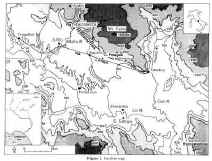|
Geoarchaeology: An International Journal, Vol. 2, No. 2(1987), 149-159
BRIDGING A SEASONAL TORRENT: THE MELFA RIVER, SOUTHERN LAZIO, ITALY
I. PETER MARTINI1, EDITH M. WIGHTMAN2 (DECEASED), and
PAMELA HEMPHILL3
1 Department of Land Resource Science, University of Guelph, Guelph,
Ontario, NlG 2W1, Canada
2Department of History, McMaster University, Hamilton, Ontario, L8S
4M1, Canada
3West Chester University, West Chester, Pennsylvania, 19383, U.S.A.
¡¡
 The Melfa River is a torrent of the intramontane Lower Liri Valley, which has
been a difficult barrier to cross since ancient times. It is dry and can be
forded during the summer, but it experiences high floods during rainy reasons,
with recurrent disruption of bridges. In Iron Age and early Roman times, fords
and bridges were located near the confluence of the river with the valley plain,
servicing the ancient Via Pedemontana. Later, faster routes with bridges were
moved toward the flatter central area of the valley. There, Romans selected a
crossing through wide braided reaches, taking advantage of fording, but
consistently losing low lying, long bridges. Traces of one and possibly two such
bridges remain along what was the Via Latina, from Fregellae to Aquino. For such
bridges, the Romans used relatively strong piers, probably linked with readily
detachable (by floods) and replaceable, wooden, flat roadways. The strategy of
Medieval and Modern civilizations was instead to bridge the river in a more
permanent way, with arches across the nearby deep gorges whose banks are
composed of stable calcareous conglomerates and sandstones. The Melfa River is a torrent of the intramontane Lower Liri Valley, which has
been a difficult barrier to cross since ancient times. It is dry and can be
forded during the summer, but it experiences high floods during rainy reasons,
with recurrent disruption of bridges. In Iron Age and early Roman times, fords
and bridges were located near the confluence of the river with the valley plain,
servicing the ancient Via Pedemontana. Later, faster routes with bridges were
moved toward the flatter central area of the valley. There, Romans selected a
crossing through wide braided reaches, taking advantage of fording, but
consistently losing low lying, long bridges. Traces of one and possibly two such
bridges remain along what was the Via Latina, from Fregellae to Aquino. For such
bridges, the Romans used relatively strong piers, probably linked with readily
detachable (by floods) and replaceable, wooden, flat roadways. The strategy of
Medieval and Modern civilizations was instead to bridge the river in a more
permanent way, with arches across the nearby deep gorges whose banks are
composed of stable calcareous conglomerates and sandstones.
|